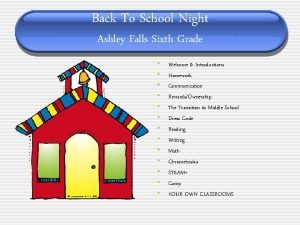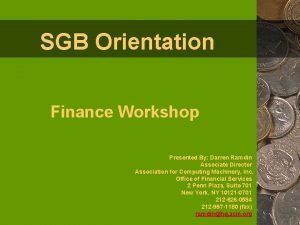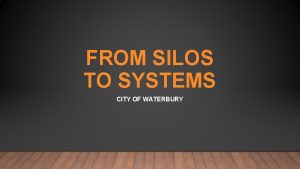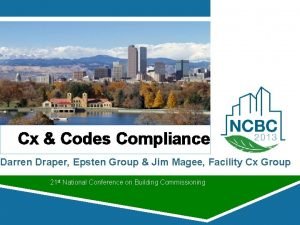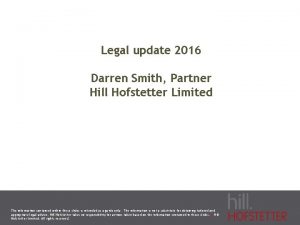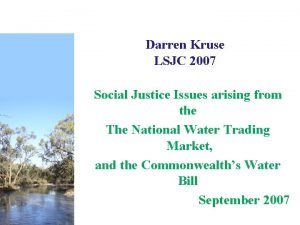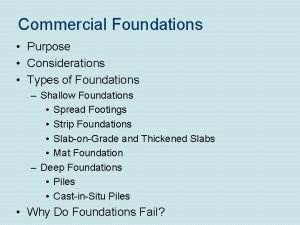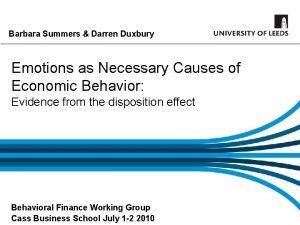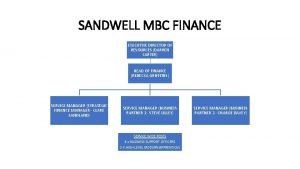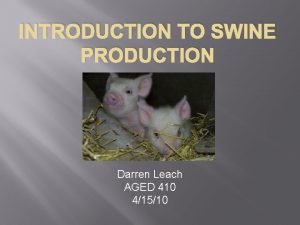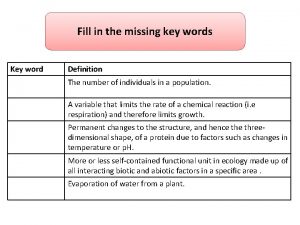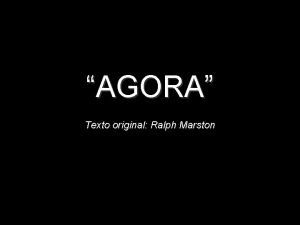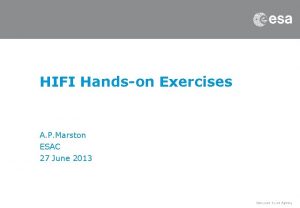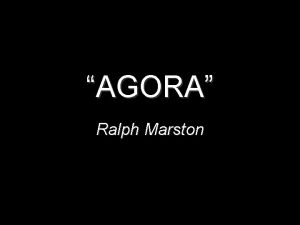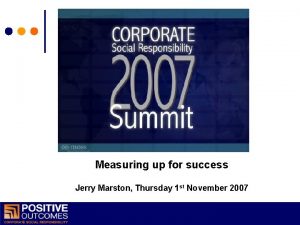The complete history of South Marston darren cookhenryandco










































- Slides: 42

The complete history of South Marston darren. cook@henryandco. uk

Sources • Books – Roman Wanborough, Highworth Hundred, Tax Lists, Inquisitions PM, Alfred Williams • Maps – early county maps, 1773 Andrews & Dury, 1840 Tithe Map, 1886 Ordnance Survey, 1918 Auction • National Archives & Wiltshire & Swindon History Centre – over 500 deeds, leases, wills, 1840 Tithe Records • Parish Records – baptisms, marriages & burials 1539 -1840 & onwards • Census Records – 1801 onwards • Archaeological records – Wiltshire Sites & Monuments Record, Archaeological Data Services, WANHS Magazine • National Monuments Record - aerial photographs • Google Earth • British Museum – pottery collection • Field-walking – fossils, pottery & coins • Landscape analysis – numerous text books • Buildings – SBC Listings Record & past buildings in the village • Internet – British History Online & Census (e. g. Freecen 1861)

Dinosaurs • 4. 6 metres, each mm one million years • repeated ages of desert, jungle, sea, ice • prehistoric sea - fossils of 500 million year old coral & 200 million year old ammonites, belemnites & bivalves • did dinosaurs exist 100 million years ago in South Marston’s Kimmeridge Clay?

Geology Ridgeway Highworth South Marston chalk alluvium clay Kimmeridge clay green sand coral limestone

Prehistoric man • 40, 000 years ago – Neanderthals? • 10, 000 – end of the Ice Age & hunter-gatherers appear along the Ridgeway? • 6, 000 - neolithic farming – SM stone axe • 4, 500 – Bronze Age civilisation – ritual & worship – SM round barrow • 2, 500 – Iron Age society – Atrebates & Dobunni, forts, pottery, burials

Neolithic stone axe from South Marston

A man-made landscape SM

Roman 43 - 410 • Ermin Street, Cunetio, mansio & Cirencester • Durocornovium population more than 3, 000 - a society that flourished for 350 years but no written record • Romano-British farming estates (c. 1800 acres) • Villas at Bishopstone & Stanton Fitzwarren – how about Earls Court & Rowborough? • S Marston road, villa, pottery, coins, SM Park burials

Roman villas in the area? Stanton Fitzwarren Rowborough ? Earls Court ? Bishopstone

South Marston’s Roman Road? Durocornovium

AD 500 Saxon Influence • AD 410 Roman administrators & soldiers leave to defend Rome from Germanic tribes • towns & economy decay - Durocornovium • towns people disperse as Saxons raid & settle in kin-based rural farms • Saxons & Britons eventually live together • Saxon charters but no written record for SM

AD 700 dispersed farms, marsh & forest (1280 names ley, ledenhull, leighmannesheys & field shapes) & north-south road to Lotmead Roman junction?

AD 900 King Alfred’s burh, security & collectivism sees arable replacing forest & nucleated village: Mersh Tun

Mersch tun – Merston • where was the marsh? The entire central area is below 95 m & Longleaze below 90 m - see Google Earth next • consider sub-soil – clay & greensand interspersed to give dispersed marsh (e. g. West Marsh & Long Marsh to the west) • consider changing climate & water table

Longleaze Farm & Great Marsh, then channels - drainage of the marsh or water meadows & cattle ponds? Do the channels pre-date the enclosed fields of 1600? l h e ot

The Feudal System • Saxon Shires divided into Hundreds of 100 tuns Highworth Hundred: Coleshill to Castle Eaton & Haydon Wick to South Marston – 30 villages by 1300 • Hundreds divided into Manors held by a lord - demesne, chapel, reeve, court & bailiff, tithingman, free tenant, villein, cottar; customary tenancies (later copyhold), rents, fines & services; nucleation & open-field system to share oxen, ploughing, good & bad soil, haymaking & harvests, in allocated ridge & furrow strips & common pasture & meadow; virgate (30) & demi-virgate (15); grain subsistence for beer, bread & pottage & animal products (wool & cheese) for market – Sainsbury’s! • Norman & Monastic exploitation of Saxon system

Royal Merston • 1086 Domesday Book omission – Saxon Royal Manor of Sevenhampton? • 1150 Queen Matilda gave an estate in Merston to the Priory of Farley • 1150 construction of the church of Mary Magdalene • 1200 -1350 Kings’ itineraries Marlborough & Lechlade (London, York, Marlborough, Leicester) • 1276 Sevenhampton Manor reverts to the Crown

AD 1200 Priory of Farley planned village, less wood & marsh, new church, road alignment, Berton & Wick East Field West Field


Medieval 1280 • 141 Merston villagers named in Manorial Court Records from 1271 -88 & comparison with Sevenhampton (70 houses) indicates: • estimated 300 people in 60 houses – the highest population until 1831 (339)! • some houses at Berton (10), Wick (10) & one or two farmsteads (Chelesies, Wydie, Ley? ) but majority in Merston (40) in toft & croft plots 30 m x 100 m, wattle, daub & thatched houses

1280 villagers named • Merston: 96 inc. 44 from the families of Thomas Warde, Richard Faber (Smith), William Yrmongar, Robert le Messor [hayward], Simon Cowherd, Walter Molendinarius [windmill? ], Robert Godchep, Jacob Renfrey, Stephen Poynant, Henry Le Bedel, Hugo Abbod, Thomas Felawe, Walter Url & Everard the chaplain…. • Berton: 21 inc. 15 from the families of William de Berton, Robert de Abendon, Hugo Stone [quarry] & Walter Hyldyth [hill ditch]… • Wick: 14 inc. Richard de Wyk (chaplain & steward of the Priory), other “de Wyks” Thomas, Nicholas, Andrew, Robert & Walter Sculhard & family, Agnes, William, Robert & Margery & “the brewers of the priory”… • Out-lying farms? inc. 10 from Johannes de la Leye, Richard de Marisco, Robert de Wydie (& Cheles ? )

1280 tracks • primary routes north-south Berton & Highworth to Wick & Ermin Street & east-west Sevenhampton Court to Stratton Market • Dark Lane to waddebroke & brokforlonge? • Green Lane to Bradymoor & Heldichesham • Pathlay to Ley Farm ? Leighmannesheys, Ledenhull, Berefurlong • (Nightingale) lane to Chelsiesmede – Chels’ Farm? • drove to north of Chelsiesmede • diagonal holloway to Priors Farley, Hackerne Bridge & Bourton • Rowborough Lane (1629) to Wydie (Great Rowborough)? • de Marisco Old Vicarage Lane drove – A 420 & O V Lane roads post-1700?

1280 tracks? No canal, railway, A 420; alternative Bourton & Lotmead routes; Dark Lane, Green Lane, Path Lay, Chelesies Drove marsh

Chelesies Drove pre-1200

1315 flooding • land use at full stretch to feed 5 million (building oak from Savernake in 1280 indicates reduced woodland) • “the chronicles describe the famine in biblical terms: rains fell nearly continuously for three years …. crops rotted & many people died of starvation or disease” • sheep murain & cattle rinderpest creates the Great Famine 1315 -21, killing 10% of the population • Did it happen here? Are we flooded every century? • Alfred Williams recalled freak weather: the ruination of Farmer Wheeler at Rowborough Farm “excessive rains came and the floods washed the whole of it away and left him penniless” & in the severe frosts of 1891 the canal was frozen for seven weeks.

1332 Tax List • tax of moveable goods of wealthier villagers • Merston is wealthy - good pasture & meadow for animal products (second in the Hundred only to Hannington & same in 1334) • familiar names from 1280: de Abyndone, atte Stone (Berton), atte Wyke & Scolarde (Wick), de Marisco, atte Leghe, atte Wydie & also Le Revehyne (Reeve for absent Priory? )

Black Death 1349 • killed 2 million of a population of 5 million in just two years (compare WWI dead 1 million of 35 million in four years) • 1377 tax record suggests 145 people died in Merston & 155 remained – did it destroy Wick? • where are they buried? • the Black Death recurred four times to 1380 & destroyed communities, religious orders, manors & the feudal system • many copyhold life tenancies were replaced by 7 year leases!

145 skeletons in South Marston?

1365 allocation • Thomas Pykote, wife Alice & son Robert rent a messuage with toft & croft between William le Cartere to the west & Andrew le Heywarde to the east [planned plots] for their lives for 6 shillings yearly, pasture for 3 oxen in the woodland & 8 acres of arable: • one acre in leighmannesheys, trokenbergh, benhull & rywardeslade • half an acre in longforlong, lowstede, stokforlonge, ledenhull & lithesmore • one & a half acres in waddebroke • illustrates copyhold landholding – about to change!

Winchester College & Leyplace • Lay or Ley (“wood clearing”) referred to in people’s names & field names 1230, 1280, 1332 • 1391 Winchester College acquires Leyplace comprising c. 60 acres (spread out in common fields) • 1393 to 1596: eight leases for terms between 7 & 40 years, rather than lifetime copyholds, with the rent decreasing from 23 shillings to 20 shows reduced population meant reduced demand for arable • WC land allocation becomes enclosed in 1640 & is centred on Pathlay, later Pidgeonhouse Farm

The missing 1400 s • few manorial, court, tax records or deeds have been published for South Marston - historical fracture in “surnames” (no more Poynant, Godchep, Wyk, Marisco, Ley, Wydie, Berton, Hyldyth etc) • 1380 -1480 golden age of wool, cloth & aristocratic magnets - Hungerfords (courtiers to the kings) had stewardship of the Priory of Farley & acquired land for themselves throughout Wiltshire, including South Marston & perhaps paid for the church tower c. 1440? • Hungerfords’ relatives from 1500 include intermarrying Wanborough/Stratton/Stanton/SM families of Brind, Cusse, Burges, Bryant & Harris & it is they who comprise SM tax payers in 1545 & 1576

Elizabethan Mansion • Manor Farm – Henry Hungerford 1576 -82 “my lower house” • Berton “Manor” – Henry Hungerford junior until 1626. • Wynnings in Leycrofte, “mansion” built by the Harris family? • Old Farm - William Brind, “the farmer of Marston” died 1577 • Cusses Place - once de Marisco? now Longleaze Farm? • Rowborough – Burgess family • Bennett’s & Beck’s & Dorothie Mundaie’s • Population 150 – 30 families Jenckins, Pinching, Edne, Grundie, Mundy, Stevens, Tayler, Lewis, Drue, Fowler, Davis, Smarte

1600 Will of Hercules Burges (1565 -1617) including 20 shillings to his servant Edmund James (1581 -1658) both in Parish Records

Family Histories • Parish Records from 1539 & WSHC 120 wills, 500 leases & deeds name the villagers • the Parish Records contain family histories for the Southbys (1670 -1832), the Mundays (1569 -1824) & the Kempsters (1687 -1840) • frequent internet enquiries from people compiling histories of Elizabethan Hungerford, Brind, Cusse & Burges & more recent villagers from the Victorian era • we have one villager who can trace her history back to 1600 – inc. Jackie Bridges’ cottage Nightingale Lane

Village hierarchy • Before 1500: classed according to type of landholding in the manor: cottar, villein, freeman, lord • After 1500: classed according to monetary wealth: husbandsman, yeoman, gentleman, squire – no “agricultural labourer” • After 1600: Enclosure, at first, creates many self -sufficient husbandsmen & yeomen farming copyhold or leasehold land of 5 to 50 acres.

1650 Enclosure & Sale • Enclosure of the common fields started with the Hungerfords in the 1400 s & was complete by 1650 • we can trace ownership of most of the parish back to 1650 • enclosed land was more valuable, the Hungerfords “gambled their wealth” at the Court of King Charles I & sold two-thirds of the Parish by 1650: central manor & Old Farm to John Southby (JP, MP, Encloures Commissioner) who rebuilt the manor house (Manor Farm) Berton (Burton Grove Farm) to the Dowe family SM Farm, Longleaze & Dorothie Munday’s to James family?

1700 s chalk & cheese • North Wiltshire Cheese boom & the Marlborough factors selling to London, new A 420 turnpike road & Old Vicarage Lane post-1700 & 1600 acres of pasture by 1840! • landed gentry of Southby, Dowe, James & Goddards joined by Hippisley, Freke & Warneford: rents increase, farms renovated & new ones built (most of those we see today) • yeomen farmers pay higher rents for farms of more than 100 acres & displace many self-sufficient husbandsmen who now become landless employees, the agricultural labourers


The worn out agricultural labourer • 1801 Census: 151 agricultural workers out of c. 190 adults in 252 population (only the gentry 3% vote) • canal, railway, industrial & agricultural revolutions alter appearance of village & way of life • Alfred Bell’s brick & slate villas with allotments replace stone, wattle & daub, thatch & meadow • 1840 Tithe Map, Censuses & 1918 Auction name people & their houses & trace change • Alfred Williams & Nelus – farming, “medieval” harvesthome feast, soldiers, railway factory • 20 th Century owner-occupation of freehold land in small house plots (320 in SM, Sevenhampton 40) • farm land becomes recreational countryside (C Forest)

Our landscape shows us • field shapes & names evidencing 1, 000 years of reclamation, occupation, ownership & Enclosure, traceable in deeds • the central channels – drainage or irrigation? • road development at expense of field tracks • features - medieval holloways, platforms, headland, wells, ponds & Parish boundaries

Our archaeology may show us • dinosaurs • a Roman villa estate & dispersed Saxon farms • our lost roads (Roman Rowborough & Lotmead N-S) • the medieval planned village, manor & windmill • burials of plague victims & the death of Wick • the remains of Wynnings, the Elizabethan mansion

New development How important to you is the preservation of our landscape & archaeology?
 Anthony marston quotes
Anthony marston quotes Https://teach.classdojo.com
Https://teach.classdojo.com Old south vs new south streetcar named desire
Old south vs new south streetcar named desire Darren baird architecture
Darren baird architecture Darren ramdin
Darren ramdin Darren gitelman
Darren gitelman Daddy making dinner
Daddy making dinner Darren schwartz waterbury
Darren schwartz waterbury Darren draper
Darren draper Darren gosbell
Darren gosbell Costless collar oil
Costless collar oil Darren perrin
Darren perrin Darren grey
Darren grey Darren barlow
Darren barlow Darren spruce
Darren spruce Darren smith roofing
Darren smith roofing Darren kruse
Darren kruse Dr ganesh
Dr ganesh Timing mode
Timing mode Darren hardy making the shift
Darren hardy making the shift Soil bearing capacity table
Soil bearing capacity table Darren duxbury
Darren duxbury Darren vella
Darren vella Darren carter sandwell
Darren carter sandwell Dr darren lim
Dr darren lim Darren kerbyson
Darren kerbyson Apptio
Apptio Darren parker
Darren parker Amanda siler
Amanda siler Darren dunkley
Darren dunkley Darren leach
Darren leach Darren hubert
Darren hubert Dr darren reed
Dr darren reed Complete the missing word to complete the three key words
Complete the missing word to complete the three key words Simple subject and predicate
Simple subject and predicate Community development history
Community development history Hát kết hợp bộ gõ cơ thể
Hát kết hợp bộ gõ cơ thể Bổ thể
Bổ thể Tỉ lệ cơ thể trẻ em
Tỉ lệ cơ thể trẻ em Gấu đi như thế nào
Gấu đi như thế nào Chụp tư thế worms-breton
Chụp tư thế worms-breton Hát lên người ơi
Hát lên người ơi

